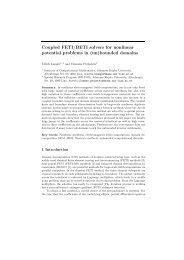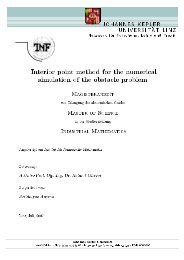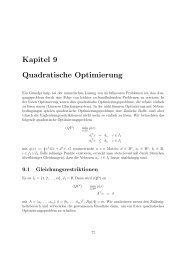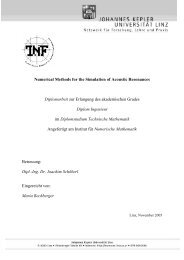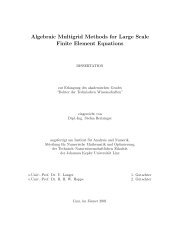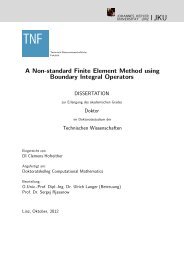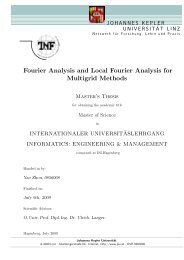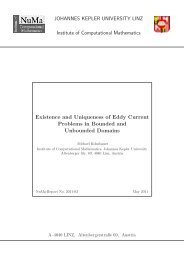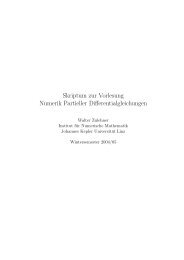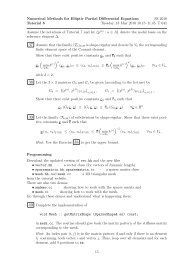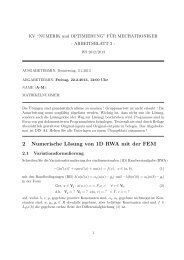PDF file - Johannes Kepler University, Linz - JKU
PDF file - Johannes Kepler University, Linz - JKU
PDF file - Johannes Kepler University, Linz - JKU
Create successful ePaper yourself
Turn your PDF publications into a flip-book with our unique Google optimized e-Paper software.
CHAPTER 3. MULTIGRID METHODS 46<br />
cells we proceed recursively as follows. Assume for a set Λ(n) that the interpolation on<br />
the unknowns in ∂Λ(n) has been fixed, 1 and we want to calculate the interpolation on the<br />
nodes in Λ(n) \ ∂Λ(n). For that we build the local stiffness matrix of Ω(n) (consisting<br />
of the element stiffness matrices of elements in Ω(n)) with the underlying partitioning<br />
(Ω(n) \ ∂Λ(n)) ∪ ∂Λ(n)<br />
( )<br />
Kii K<br />
K Ω(n) =<br />
ib } Ω(n) \ ∂Λ(n)<br />
K bi K bb } ∂Λ(n)<br />
(i stands for interior, b for boundary) and perform local energy minimization:<br />
( ) ( )<br />
find u i such that (u T i u T Kii K<br />
b )<br />
ib ui<br />
is minimized, with given u<br />
K bb u b ,<br />
b<br />
K bi<br />
with the result (for symmetric, positive definite K Ω(n) )<br />
Now we can set<br />
(P F C ) j,k =<br />
where ˜P j is the localized version of P l<br />
l+1 .<br />
[<br />
u i = −K −1<br />
ii K ib u b .<br />
( ( ) )<br />
0 ←<br />
−K −1<br />
vertices of Λ(j) \ {k}<br />
ii K ib<br />
˜P j<br />
1 ← k .<br />
Remark 3.12. The drawback of this method is a possibly expensive set-up phase, as many<br />
local minimization problems have to be solved and one has to save all the element stiffness<br />
matrices. Approaches to overcome this difficulty can be found in [HV01].<br />
Remark 3.13. A very nice property of element agglomerating AMGe is the complete information<br />
about grid topology on the coarse levels. This could be utilized in various ways, so<br />
e.g. stability analysis for saddle point problems can be performed nearly as in a geometric<br />
context (c.f. Section 4.1.3) or as another example one could use the information to<br />
construct some FAS-like schemes 2 for nonlinear problems, which is done in [JVW02].<br />
∂Λ(j)<br />
]<br />
j<br />
,<br />
What we have not specified yet is how to construct the coarse agglomerates.<br />
possibility for that is the following algorithm.<br />
One<br />
1 The ‘boundary’ ∂Λ(n) is defined straightforward: if Λ(n) is a face then ∂Λ(n) are those nodes of Λ(n)<br />
which belong to more than one face, if Λ(n) is an agglomerated element then ∂Λ(n) is the union of faces<br />
of this element.<br />
2 FAS . . . full approximation storage, a multigrid method which is capable of solving nonlinear problems,<br />
developed by Brandt [Bra77].




